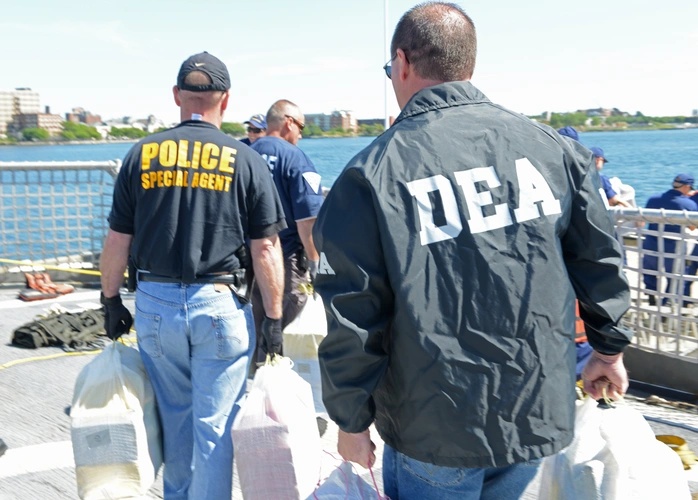Summary: Trump Issues Three Executive Orders on Crime and Law Enforcement
This week, after a long, partisan confirmation battle, the Senate confirmed Senator Jeff Sessions (R-AL) as the United States Attorney General.
Published by The Lawfare Institute
in Cooperation With

This week, after a long, partisan confirmation battle, the Senate confirmed Senator Jeff Sessions (R-AL) as the United States Attorney General. President Trump hosted Sessions for a swearing-in ceremony at the White House, during which Sessions declared, “We need to end this [immigration] lawlessness that threatens the public safety, pulls down the wages of working Americans.” Significantly, the President also signed three executive orders at the ceremony—orders that appear to address Sessions’ statement and the President’s own campaign rhetoric concerning crime, illegal aliens, and drug trafficking.
These directives, summarized below, focus on law enforcement activity in the context of transnational criminal organizations, violent crime, and violence perpetrated against law enforcement officers. All three orders were promulgated under the President’s authority under the Constitution; no statutes or other laws were invoked to justify the orders’ implementation.
Transnational Criminal Organizations (TOCs) Order
The first order, “Enforcing Federal Law with respect to Transnational Criminal Organizations and Preventing International Trafficking,” seeks to “strengthen enforcement of federal law in order to thwart,” among other entities, “criminal gangs, cartels, [and] racketeering organizations.” To that end, the order redirects the efforts of the Threat Migration Working Group, an interagency organization established by President Obama and originally charged to “identify those TOC [transnational criminal organization] networks that present a sufficiently high national security risk and will ensure the coordination of all elements of national power to combat them.”
In the order’s statement of purpose, the President asserts that TCOs “have spread throughout the Nation, threatening the safety of the United States and its citizens. Significantly, the order’s purpose highlights “trafficking by cartels of controlled substances,” which “has triggered a resurgence in deadly drug abuse and a corresponding rise in violent crime related to drugs.” Having characterized TCOs as a serious threat to the United States, the President then states, “A comprehensive and decisive approach is required to dismantle these organized crime syndicates.”
Section 2 of the order provides, “It shall be the policy of the executive branch to . . . strengthen enforcement of Federal law in order to thwart” TCOs. The directive also mandates “that Federal law enforcement agencies give a high priority and devote sufficient resources to efforts to identify, interdict, disrupt, and dismantle [TCOs].” Further, the order requires additional interagency cooperation, information sharing, and strategy development. Moreover, the President calls for “the swift removal from the United States of foreign nationals who are members of TCOs” and increased “efforts to . . . prosecut[e] . . . immigration fraud and visa fraud.”
To implement these objectives, the order instructs “the Secretary of State, the Attorney General, the Secretary of Homeland Security, and the Director of National Intelligence [to] co chair and direct the existing interagency Threat Mitigation Working Group,” which must, among other duties:
- “[W]ork to support and improve the coordination of Federal agencies’ efforts to identify, interdict, investigate, prosecute, and dismantle [TCOs] within and beyond the United States.”
- “[A]ssess Federal agencies’ practices, any absence of practices, and funding needs that might hinder Federal efforts to effectively combat [TCOs].”
- “[R]eview relevant Federal laws to determine existing ways in which to identify, interdict, and disrupt the activity of [TROs], and ascertain which statutory authorities, including provisions under the Immigration and Nationality Act, could be better enforced or amended to prevent foreign members of these organizations or their associates from obtaining entry into the United States and from exploiting the United States immigration system.”
- “[I]ssue reports at least once per quarter detailing convictions in the United States relating to [TCOs].”
- “[W]ithin 120 days of the date of this order, submit to the President a report on [TCOs], including the extent of penetration of such organizations into the United States.”
Crime Prevention Order
The second order, “Task Force on Crime Reduction and Public Safety,” seeks “to reduce crime and restore public safety.” In Section 1, the order states, “It shall be the policy of the executive branch to reduce crime in America.” Like the first order, this directive also focuses on unlawful aliens: the new strategy “requires a commitment to enforcing the law and developing policies that comprehensively address illegal immigration, drug trafficking, and violent crime.”
To effect a reduction in crime, the President, in Section 2, “direct[s] the Attorney General to establish . . . a Task Force on Crime Reduction and Public Safety (Task Force).” Although the Attorney General has the discretion to “determine the characteristic,” composition, and meeting schedule of the Task Force,” the entity must:
- “[E]xchange information and ideas among its members that will be useful in developing strategies to reduce crime.”
- “[D]evelop strategies to reduce crime.”
- “[I]dentify deficiencies in existing laws that have made them less effective in reducing crime and propose new legislation that could be enacted to improve public safety and reduce crime.”
- “[E]valuate the availability and adequacy of crime-related data and identify measures that could improve data collection.”
- “[C]onduct any other studies and develop any other recommendations as directed by the Attorney General.”
And mirroring the obligation imposed by the first order, the Task Force must “submit at least one report to the President within 1 year from the date of this order, and a subsequent report at least once per year thereafter while the Task Force remains in existence.”
Protecting Law Enforcement Order
The third order released today, “Preventing Violence Against Federal, State, Tribal, and Local Law Enforcement Officers,” establishes that the “enforce[ment] of all Fedearl laws in order to enhance the protection and safety of . . . law enforcement officers, and thereby all Americans,” “shall be the policy of the executive branch.” The order also establishes as policy: (i) the “develop[ment] of strategies . . . to further enhance the protection of . . . law enforcement officers”; and (ii) the “pursu[it] of appropriate legislation . . . that will define new Federal crimes, and increase penalties for existing Federal crimes, in order to prevent violence against . . . law enforcement officers.”
Like the second order, the Attorney General is responsible for implementing the directive’s policies. The order stipulates that “the Attorney General shall:
- develop a strategy for the [Justice] Department’s use of existing Federal laws to prosecute individuals who commit or attempt to commit crimes of violence against . . . law enforcement officers;
- coordinate with [governments and agencies] at all levels . . . in prosecuting crimes of violence against . . . law enforcement officers in order to advance adequate multi-jurisdiction prosecution efforts;
- review existing Federal laws to determine whether those laws are adequate to address the protection and safety of . . . law enforcement officers;
- following that review, . . . as appropriate, make recommendations to the President for legislation to address the protection ad safety of . . . law enforcement officers, including, if warranted, legislation defining new crimes . . . and establishing new mandatory minimum sentences for existing crimes . . .;
- coordinate with other Federal agencies to develop an executive branch strategy . . .;
- thoroughly evaluate all grant funding programs currently administered by the Department . . .;
- recommend to the President any changes to grant funding, based on the evaluation required by . . . this section.”
Significantly, all three of these orders reflect the administration’s focus on illegal immigration and crime perpetrated by unlawful aliens. Further, the orders may signal a shift towards greater enforcement of drug-related crimes—two of the orders specifically state that drug trafficking is a priority target of the new administration. And in light of developments such as the release of the Ninth Circuit’s decision affirming the stay on the President’s controversial immigration order, the administration may rely on additional domestic law enforcement measures to achieve what it perceives as important security policy objectives.





